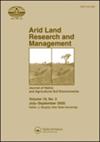红粒小麦地方品种抗旱性的适应性状
IF 1.6
4区 农林科学
Q3 ENVIRONMENTAL SCIENCES
引用次数: 9
摘要
摘要收集了来自巴基斯坦干旱和半干旱地区的49份材料,探讨了红粒小麦(Triticum aestivum L.)的适应成分。单系选材分别在干旱和对照地点种植;即费萨拉巴德的乌奇克拉农场(UF)和植物园(BG)。BG处理下的生物量和产量均显著高于UF处理。Chakwal的Ck5和Jm3分别在BG和UF处理下产量最高(分别为17.7 g和8.1 g)。在进行进一步解剖研究的8个材料中,Dg2在UF下单株产量增加,这与根修饰有关,如皮质区厚度增加、内胚层细胞面积增加、维管区厚度增加、质质部面积增加和根毛长度增加。茎的变化包括维管束面积、韧皮部面积和气孔密度增加,而叶片的角质层厚度、球状细胞厚度、毛状体密度和长度增加。气孔密度和面积增加。处理Jm3在超滤条件下产量下降。Jm3的根修饰包括表皮细胞面积、厚壁组织厚度、内胚层细胞面积和根毛长度的增加。干细胞修饰包括增加干细胞区域厚度和厚壁细胞面积。叶片背面表皮细胞面积增加,毛状体数量和长度增加,背面气孔密度增加。综上所述,两个试验点红粒小麦的形态解剖特征差异很大,这有可能用于现代小麦品种的耐旱性育种工作。本文章由计算机程序翻译,如有差异,请以英文原文为准。
Adaptive traits for drought tolerance in red-grained wheat (Triticum aestivum L.) landraces
Abstract Forty-nine accessions were collected from arid and semi-arid areas of Pakistan to explore adaptive components in red-grained wheat (Triticum aestivum L.). Single-line selections of these accessions were grown on an arid and a control site; that is, Uchkera Farm (UF) and Botanical Garden (BG), Faisalabad. The accessions grown at BG exhibited significantly better biomass and grain yield production than those grown at UF. Accession Ck5 from Chakwal produced the maximum grain yield (17.7 g plant−1) at BG and Jm3 (8.1 g plant−1) at UF. Among the eight accessions selected for further anatomical studies, Dg2 showed increased yield per plant at UF, which was related to root modifications like increased cortical region thickness, endodermal cell area, vascular region thickness, metaxylem area, and root hair length. Stem modifications included increased vascular bundle area, phloem area and stomatal density, while leaves showed increased cuticle thickness, bulliform cell thickness, trichome density, and length. Increased stomatal density and area were also found. Accession Jm3 showed a decrease in yield at UF. Root modifications in Jm3 included increased epidermal cell area, sclerenchymatous thickness, endodermal cell area, and root hair length. Stem modifications in this accession included increased stem cellular region thickness and sclerenchymatous cell area. Leaves had increased abaxial epidermal cell area, trichome number and length, and abaxial stomatal density. In conclusion, morpho-anatomical characteristics varied greatly in the red-grained wheat accessions at both experimental sites that have potential for incorporation into breeding efforts for drought tolerance in modern wheat cultivars.
求助全文
通过发布文献求助,成功后即可免费获取论文全文。
去求助
来源期刊

Arid Land Research and Management
环境科学-环境科学
CiteScore
3.80
自引率
7.10%
发文量
23
审稿时长
9 months
期刊介绍:
Arid Land Research and Management, a cooperating journal of the International Union of Soil Sciences , is a common outlet and a valuable source of information for fundamental and applied research on soils affected by aridity. This journal covers land ecology, including flora and fauna, as well as soil chemistry, biology, physics, and other edaphic aspects. The journal emphasizes recovery of degraded lands and practical, appropriate uses of soils. Reports of biotechnological applications to land use and recovery are included. Full papers and short notes, as well as review articles and book and meeting reviews are published.
 求助内容:
求助内容: 应助结果提醒方式:
应助结果提醒方式:


